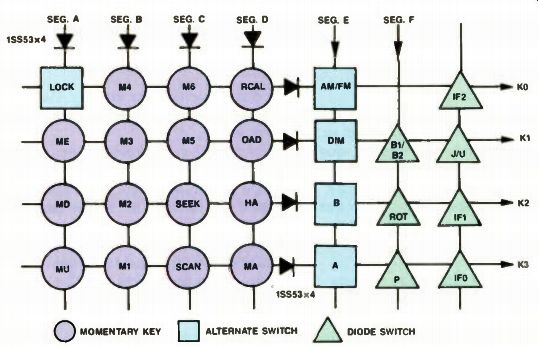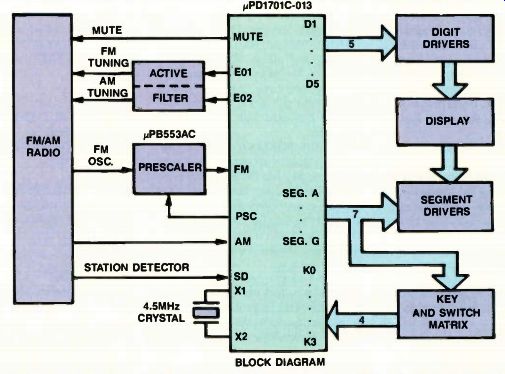Electronically tuned radios
By Craig R. Seelig
Seelig, an electronics servicing consultant, has spent the last 11 years doing circuit-design, prototyping and troubleshooting for a car stereo manufacturing company.
Audio Corner in December described the circuitry and operation of electronically tuned radios (ETRs). Part II will discuss the control key and mode switch matrix. This part also will describe troubleshooting methods for these circuits.
The switch matrix
Part 1 of this series described NEC's PD1701C-013, a common electronic tuning system control IC found in both home and car stereo equipment. The control IC, a microprocessor chip, accepts inputs from the tuning controls, AM and FM oscillators, the station detector and the turning controls. It pro-vides control outputs for tuning, mute and the visual display. The control IC also provides user interface functions, including multiplexing signals for the digital display drivers and a 4 x7 control and mode switch matrix. Matrix locations designated by a triangle (see Figure 1) allow the circuit designer to "strap" in certain system functions, such as IF frequencies used and AM channel spacing. (European AM channel spacing is 9 khz.) This flexibility allows the device to be used in many markets.
Locations designated by squares are alternate switch locations where, by means of mechanical push-push switches or transistor switches, such functions as bandswitching and display dimming are accomplished. Locations designated by circles are momentary key positions that control such functions as manual up/down tuning, seek/scan and preset address. Conductive-rubber con tact switches are often used in these positions.

Figure 1. The control key matrix of an electronically tuned radio is shown
here. The matrix locations designated by a triangle allow the circuit designer
to "strap" in certain system functions such as IF frequencies and
AM channel spacing.

Figure 2. In an electronically tuned radio, a microprocessor selects from
a finite number of assigned radio channels. The block diagram of the tuning
circuitry of a typical electronically tuned radio is shown here.
Troubleshooting
You often can troubleshoot ailing ETRs by carefully analyzing the symptoms. What functions of the control circuit are operating normally? Is it just FM (or AM) that is not working? Is a valid frequency being displayed by the IC? (See the block diagram in Figure 2.
For the schematic, refer to Figure 1A in the December issue.) In the majority of cases where a valid frequency is being displayed, the control IC will be operating properly. If a valid frequency is not visible, check for the presence of 5V on pins 3 and 14.
Catastrophic failure of the microprocessor-control IC may load down the B+ supply to pin 14. If this is the case, opening the solder joint here will return the supply line to 5V and confirm a defective IC. When supply voltages are normal, check for the presence of 4.5MHz at the crystal (use an isolation resistor). If the oscillator is running and the digital display is blank, check for B+ at the segment driver IC. If a valid display is shown, but the control IC is not responding to any key board commands, check for the typical cause: a stuck momentary push-button.
If the control IC is initialized with a key stuck in the down position, it will not respond to any key commands.
Proper operation of the ETR's PLL is easily verified. Place the radio in the seek or scan mode with the antenna shorted. Monitor the varactor tuning voltage line while the control IC is scanning. When the PLL is locked, this voltage should be a smooth ramp. The only abrupt voltage change should occur when the displayed frequency changes from one end of the band to the other.
Any interruption of any part of the PLL loop, such as loss of sample local oscillator RF, characteristically will cause the tuning voltage line to stay near B+. It is unlikely that both AM and FM oscillator circuits would become defective at the same time. Therefore, if the PLL tuning voltage does not ramp in either radio mode, the charge-pump/low pass filter or control IC would be suspect (assuming radio B+ and B+ switching circuits are OK. Alignment of the PLL is a simple matter of setting the display frequency to the highest channel and adjusting the appropriate local oscillator tank coil or trimmer to achieve the specified tuning voltage as measured at the output of the charge pump.
With an understanding of the various function blocks comprising the electronic tuning system and the influence they each have on overall receiver operation, any technician should be able to quickly isolate the defective subsystem.